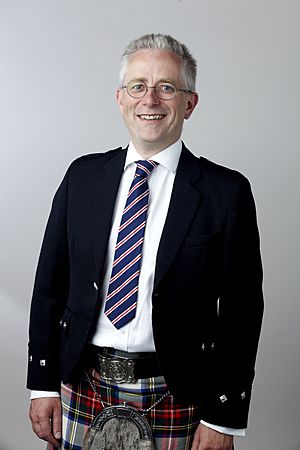James Naismith (chemist) facts for kids
Quick facts for kids
James Naismith
FRS FRSE FMedSci MAE FRSC FInstP FRSB
|
|
|---|---|

James Naismith at the Royal Society admissions day in July 2014
|
|
| Born |
James Henderson Naismith
26 July 1968 Bellshill, Scotland
|
| Nationality | Scottish, British |
| Other names | Jim Naismith |
| Citizenship | United Kingdom |
| Alma mater |
|
| Known for | Structural biology |
| Spouse(s) | Rachel Middleton |
| Children | 2 |
| Awards |
|
| Scientific career | |
| Fields |
|
| Institutions |
|
| Thesis | Structural studies of concanavalin A and zinc aldolase (1992) |
| Doctoral advisor |
|
James Henderson Naismith, born on July 26, 1968, is a Scottish scientist. He is a Professor of Structural Biology and, since the autumn of 2023, has been the Head of the Mathematical, Physical, and Life Science Division (MPLS) at the University of Oxford.
Before this, he was the first Director of the Rosalind Franklin Institute. He also led the Research Complex at Harwell. Earlier in his career, he was a professor of Chemical Biology at the University of St Andrews. He was part of the Council of the Royal Society from 2021 to 2022. Currently, he is also the Vice-Chair of the European X-ray Free Electron Laser and a Vice-President of The Academy of Medical Sciences.
Contents
Learning and Degrees
James Naismith was named after King James VI and I. He went to Hamilton Grammar School. He then studied at the University of Edinburgh, where he earned a top Bachelor of Science degree in chemistry in 1989.
He received a special scholarship to work at the University of Manchester. There, he earned his PhD in 1992. His research focused on the chemical structure of important proteins called Concanavalin A and Zinc aldolase. In 2016, the University of St Andrews awarded him a higher degree called a Doctor of Science (DSc).
Career and Scientific Work
After getting his PhD, Professor Naismith moved to the University of Texas Southwestern Medical Center. He worked there as a NATO Fellow doing advanced research. In 1995, he became a lecturer at the University of St Andrews. He became a Professor there in 2001.
Professor Naismith's research looks at how to understand the shapes of proteins. He uses a method called X-ray crystallography. This helps him learn how biological systems work and how to fight diseases.
What His Research Explores
His team studies several key areas:
- How cells send and receive signals (called signal transduction).
- How proteins interact with carbohydrates (sugars).
- How harmful bacteria build their sugar chains (glycans). They have found and studied enzymes involved in these steps.
- How viruses copy themselves. They are studying a protein crucial for virus replication.
- How unusual natural products are made by living things.
Many important organizations have funded his research. These include the Biotechnology and Biological Sciences Research Council (BBSRC) and the Medical Research Council (MRC).
In 2017, Professor Naismith joined the University of Oxford. He became a Professor of Structural Biology. From 2017 to 2019, he directed the Research Complex at Harwell. He also led the Rosalind Franklin Institute starting in 2018.
Awards and Special Recognitions
Professor Naismith has received many awards for his scientific work. In 2000, he won the Dextra Carbohydrate award. In 2009, he received the Jeremy Knowles Prize in Chemical Biology. Both awards came from the Royal Society of Chemistry.
In 2014, he was chosen as a Fellow of the Royal Society (FRS). This is a very high honor for scientists. He was recognized for his amazing work in understanding proteins. His research showed new ways that proteins recognize other molecules like nucleic acids and carbohydrates. He also discovered new chemical processes in enzymes.
In 2022, Professor Naismith was part of a team that won a Royal Society of Chemistry Horizon Prize. They won for their work on special antibodies called nanobodies that help fight Covid19.
He is also a Fellow of the Royal Society of Chemistry (FRSC) and the Royal Society of Biology (FRSB). He is a member of the European Molecular Biology Organization (EMBO). In 2016, he became a Fellow of the American Association for the Advancement of Science (AAAS). In 2022, he was elected a member of Academia Europaea (AE).
He was recognized by the Academy of Medical Sciences for his work on antibiotic resistance. He has dedicated his career to finding new ways to fight harmful microbes.
Family Life
Professor Naismith is married to Rachel Middleton. They have two children, a son and a daughter.

